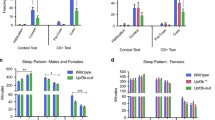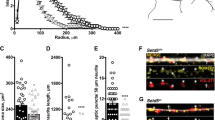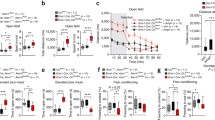Abstract
The gene CUG-BP, Elav-like factor 6 (CELF6) appears to be important for proper functioning of neurocircuitry responsible for behavioral output. We previously discovered that polymorphisms in or near CELF6 may be associated with autism spectrum disorder (ASD) in humans and that the deletion of this gene in mice results in a partial ASD-like phenotype. Here, to begin to understand which circuits might mediate these behavioral disruptions, we sought to establish in what structures, with what abundance, and at which ages Celf6 protein is present in the mouse brain. Using both a knockout-validated antibody to Celf6 and a novel transgenic mouse line, we characterized Celf6 expression in the mouse brain across development. Celf6 gene products were present early in neurodevelopment and in adulthood. The greatest protein expression was observed in distinct nuclei of the diencephalon and neuromodulatory cell populations of the midbrain and hindbrain, with clear expression in dopaminergic, noradrenergic, histaminergic, serotonergic and cholinergic populations, and a variety of presumptive peptidergic cells of the hypothalamus. These results suggest that disruption of Celf6 expression in hypothalamic nuclei may impact a variety of behaviors downstream of neuropeptide activity, while disruption in neuromodulatory transmitter expressing areas such as the ventral tegmental area, substantia nigra, raphe nuclei and locus coeruleus may have far-reaching influences on overall brain activity.












Similar content being viewed by others
Abbreviations
- 10N:
-
Dorsal motor nucleus of vagus
- 3N:
-
Oculomotor nucleus
- A12:
-
A12 dopamine cells
- A13:
-
A13 dopamine cells
- A14:
-
A14 dopamine cells
- Acb:
-
Accumbens nucleus
- AcbC:
-
Accumbens nucleus, core
- AcbSh:
-
Accumbens nucleus, shell
- AHA:
-
Anterior hypothalamic area, anterior part
- Amb:
-
Ambiguus nucleus
- Arc:
-
Arcuate hypothalamic nucleus
- Au1:
-
Primary auditory cortex
- AuD:
-
Secondary auditory cortex, dorsal area
- AuV:
-
Secondary auditory cortex, ventral area
- CP:
-
Caudoputamen (striatum)
- DM:
-
Dorsomedial hypothalamic nucleus
- DR:
-
Dorsal raphe nucleus
- EW:
-
Edinger–Westphal nucleus
- GP:
-
Globus pallidus
- HDB:
-
Nucleus of the horizontal limb of the diagonal band
- IO:
-
Inferior olivary nucleus
- LC:
-
Locus coeruleus
- LDTg:
-
Laterodorsal tegmental nucleus
- LH:
-
Lateral hypothalamic area
- LHb:
-
Lateral habenular nucleus
- LMol:
-
Lacunosum moleculare layer of the hippocampus
- LPO:
-
Lateral preoptic area
- LRt:
-
Lateral reticular nucleus
- MHb:
-
Medial habenular nucleus
- MnR:
-
Median raphe nucleus
- MPA:
-
Medial preoptic area
- MS:
-
Medial septal nucleus
- MTu:
-
Medial tuberal nucleus
- MVeMC:
-
Medial vestibular nucleus, magnocellular part
- Pa:
-
Paraventricular hypothalamic nucleus
- PAG:
-
Periaqueductal gray
- PDTg:
-
Posterodorsal tegmental nucleus
- Pe:
-
Periventricular hypothalamic nucleus
- PnC:
-
Pontine reticular nucleus, caudal part
- PTg:
-
Pedunculotegmental nucleus
- PV:
-
Paraventricular thalamic nucleus
- Rad:
-
Radiatum layer of the hippocampus
- RMg:
-
Raphe magnus nucleus
- RO:
-
Raphe obscurus nucleus
- RPa:
-
Raphe pallidus nucleus
- SI:
-
Substantia innominata
- SIB:
-
Substantia innominata, basal part
- SNc:
-
Substantia nigra, compact part
- SO:
-
Supraoptic nucleus
- TeA:
-
Temporal association cortex
- V1B:
-
Primary visual cortex, binocular area
- VDB:
-
Nucleus of the vertical limb of the diagonal band
- VLPO:
-
Ventrolateral preoptic nucleus
- VTA:
-
Ventral tegmental area
References
Alenina N et al (2009) Growth retardation and altered autonomic control in mice lacking brain serotonin. Proc Natl Acad Sci USA 106:10332–10337. doi:10.1073/pnas.0810793106
Angoa-Perez M et al (2012) Genetic depletion of brain 5HT reveals a common molecular pathway mediating compulsivity and impulsivity. J Neurochem 121:974–984. doi:10.1111/j.1471-4159.2012.07739.x
Arriaga G, Zhou EP, Jarvis ED (2012) Of mice, birds, and men: the mouse ultrasonic song system has some features similar to humans and song-learning birds. PLoS One 7:e46610. doi:10.1371/journal.pone.0046610
Barreau C, Paillard L, Mereau A, Osborne HB (2006) Mammalian CELF/Bruno-like RNA-binding proteins: molecular characteristics and biological functions. Biochimie 88:515–525. doi:10.1016/j.biochi.2005.10.011
Brimacombe KR, Ladd AN (2007) Cloning and embryonic expression patterns of the chicken CELF family. Dev Dyn 236:2216–2224. doi:10.1002/dvdy.21209
Cook EH Jr, Leventhal BL (1996) The serotonin system in autism. Curr Opin Pediatr 8:348–354
Dalal J et al (2013) Translational profiling of hypocretin neurons identifies candidate molecules for sleep regulation. Genes Dev 27:565–578. doi:10.1101/gad.207654.112
Dasgupta T, Ladd AN (2012) The importance of CELF control: molecular and biological roles of the CUG-BP, Elav-like family of RNA-binding proteins. Wiley Interdiscip Rev RNA 3:104–121. doi:10.1002/wrna.107
Dillman AA et al. (2013) mRNA expression, splicing and editing in the embryonic and adult mouse cerebral cortex. Nat Neurosci 16:499–506. http://www.nature.com/neuro/journal/v16/n4/abs/nn.3332.html
Dougherty JD et al (2013) The disruption of Celf6, a gene identified by translational profiling of serotonergic neurons, results in autism-related behaviors. J Neurosci 33:2732–2753. doi:10.1523/JNEUROSCI.4762-12.2013
Doyle JP et al (2008) Application of a translational profiling approach for the comparative analysis of CNS cell types. Cell 135:749–762. doi:10.1016/j.cell.2008.10.029
Dredge BK, Jensen KB (2011) NeuN/Rbfox3 nuclear and cytoplasmic isoforms differentially regulate alternative splicing and nonsense-mediated decay of Rbfox2. PLoS One 6:e21585. doi:10.1371/journal.pone.0021585
Franklin KBJ, Paxinos G (2007) The mouse brain in stereotaxic coordinates. 3rd edn. Academic Press, New York, NY
Garg S, Green J, Leadbitter K, Emsley R, Lehtonen A, Evans DG, Huson SM (2013) Neurofibromatosis Type 1 and Autism Spectrum Disorder. Pediatrics 132:e1642–e1648. doi:10.1542/peds.2013-1868
Gong S, Kus L, Heintz N (2010) Rapid bacterial artificial chromosome modification for large-scale mouse transgenesis. Nat Protoc 5:1678–1696
Good PJ, Chen Q, Warner SJ, Herring DC (2000) A family of human RNA-binding proteins related to the Drosophila Bruno translational regulator. J Biol Chem 275:28583–28592. doi:10.1074/jbc.M003083200
Kane MJ, Angoa-Perez M, Briggs DI, Sykes CE, Francescutti DM, Rosenberg DR, Kuhn DM (2012) Mice genetically depleted of brain serotonin display social impairments, communication deficits and repetitive behaviors: possible relevance to autism. PLoS One 7:e48975. doi:10.1371/journal.pone.0048975
Ladd AN (2013) CUG-BP, Elav-like family (CELF)-mediated alternative splicing regulation in the brain during health and disease. Mol Cell Neurosci 56:456–464. doi:10.1016/j.mcn.2012.12.003
Ladd AN, Charlet N, Cooper TA (2001) The CELF family of RNA binding proteins is implicated in cell-specific and developmentally regulated alternative splicing. Mol Cell Biol 21:1285–1296. doi:10.1128/MCB.21.4.1285-1296.2001
Ladd AN, Nguyen NH, Malhotra K, Cooper TA (2004) CELF6, a member of the CELF family of RNA-binding proteins, regulates muscle-specific splicing enhancer-dependent alternative splicing. J Biol Chem 279:17756–17764. doi:10.1074/jbc.M310687200
Lind D, Franken S, Kappler J, Jankowski J, Schilling K (2005) Characterization of the neuronal marker NeuN as a multiply phosphorylated antigen with discrete subcellular localization. J Neurosci Res 79:295–302. doi:10.1002/jnr.20354
Maloney SE, Rieger MA, Dougherty JD (2013) Identifying essential cell types and circuits in autism spectrum disorders. Int Rev Neurobiol 113:61–96. doi:10.1016/B978-0-12-418700-9.00003-4
May PJ, Reiner AJ, Ryabinin AE (2008) Comparison of the distributions of urocortin-containing and cholinergic neurons in the perioculomotor midbrain of the cat and macaque. J Comp Neurol 507:1300–1316. doi:10.1002/cne.21514
McDougle CJ, Naylor ST, Goodman WK, Volkmar FR, Cohen DJ, Price LH (1993) Acute tryptophan depletion in autistic disorder: a controlled case study Biol Psychiatry 33:547–550. pii: 0006-3223(93)90011-2
Mosienko V, Bert B, Beis D, Matthes S, Fink H, Bader M, Alenina N (2012) Exaggerated aggression and decreased anxiety in mice deficient in brain serotonin. Transl psychiatry 2:e122. doi:10.1038/tp.2012.44
Puelles L, Martinez-de-la-Torre M, Ferran J-L, Watson C (2012) Diencephalon. In: Watson C, Paxinos G, Puelles L (eds) The Mouse Nervous System. Academic Press, London
Sears LL, Vest C, Mohamed S, Bailey J, Ranson BJ, Piven J (1999) An MRI study of the basal ganglia in autism. Prog Neuro-Psychopharmacol Biol Psychiatry 23:613–624
Tupal S, Rieger MA, Ling GY, Park TJ, Dougherty JD, Goodchild AK, Gray PA (2014) Testing the role of preBotzinger complex somatostatin neurons in respiratory and vocal behaviors. Eur J Neurosci. doi:10.1111/ejn.12669
Underwood JG, Boutz PL, Dougherty JD, Stoilov P, Black DL (2005) Homologues of the Caenorhabditis elegans Fox-1 protein are neuronal splicing regulators in mammals. Mol Cell Biol 25:10005–10016. doi:10.1128/mcb.25.22.10005-10016.2005
Wagnon JL et al (2012) CELF4 regulates translation and local abundance of a vast set of mRNAs, including genes associated with regulation of synaptic function. PLoS Genet 8:e1003067. doi:10.1371/journal.pgen.1003067
Watson C (2012a) Hindbrain. In: Watson C, Paxinos G, Puelles L (eds) The Mouse Nervous System. Academic Press, London
Watson C (2012b) Motor nuclei of the cranial nerves. In: Watson C, Paxinos G, Puelles L (eds) The Mouse Nervous System. Academic Press, London
Acknowledgments
The authors would like to thank Arthur Loewy, Paul Gray, Nathaniel Heintz, and Cristina de Guzman Strong for equipment, reagents and discussion. We would also like to thank Heifen Feng, Juliet Zhang, and Afua Akuffo for technical assistance. Funding was provided by R21MH099798, DA038458-01, R00NS067239 to JDD, and an ACE network grant R01MH100027.
Conflict of interest
None of the authors has any established or potential conflict of interest to declare in relation with the current work.
Author information
Authors and Affiliations
Corresponding author
Rights and permissions
About this article
Cite this article
Maloney, S.E., Khangura, E. & Dougherty, J.D. The RNA-binding protein Celf6 is highly expressed in diencephalic nuclei and neuromodulatory cell populations of the mouse brain. Brain Struct Funct 221, 1809–1831 (2016). https://doi.org/10.1007/s00429-015-1005-z
Received:
Accepted:
Published:
Issue Date:
DOI: https://doi.org/10.1007/s00429-015-1005-z




